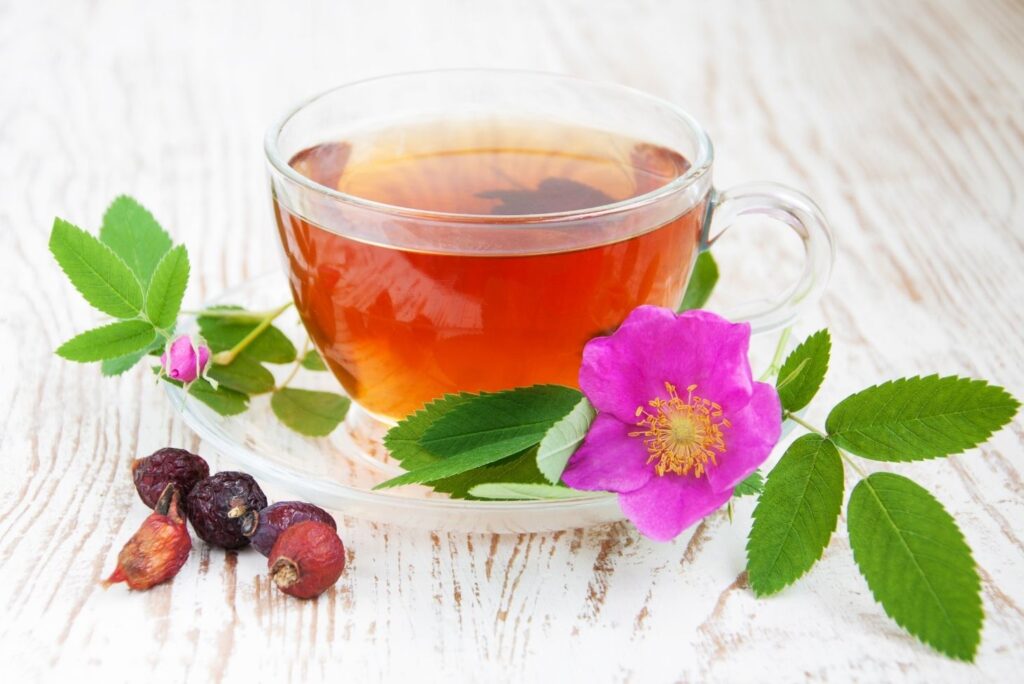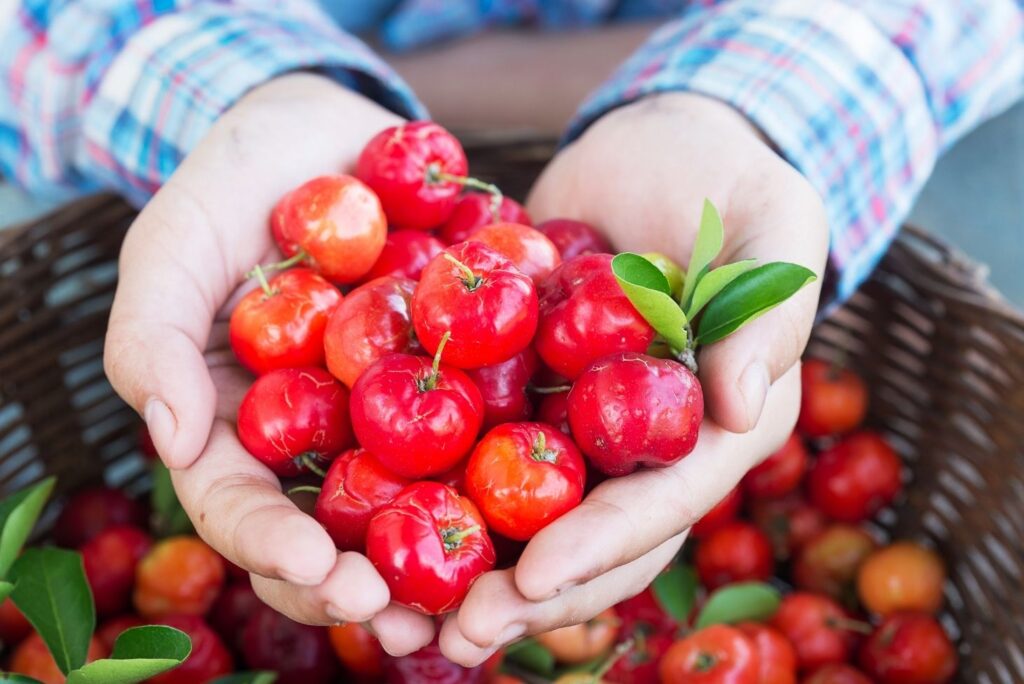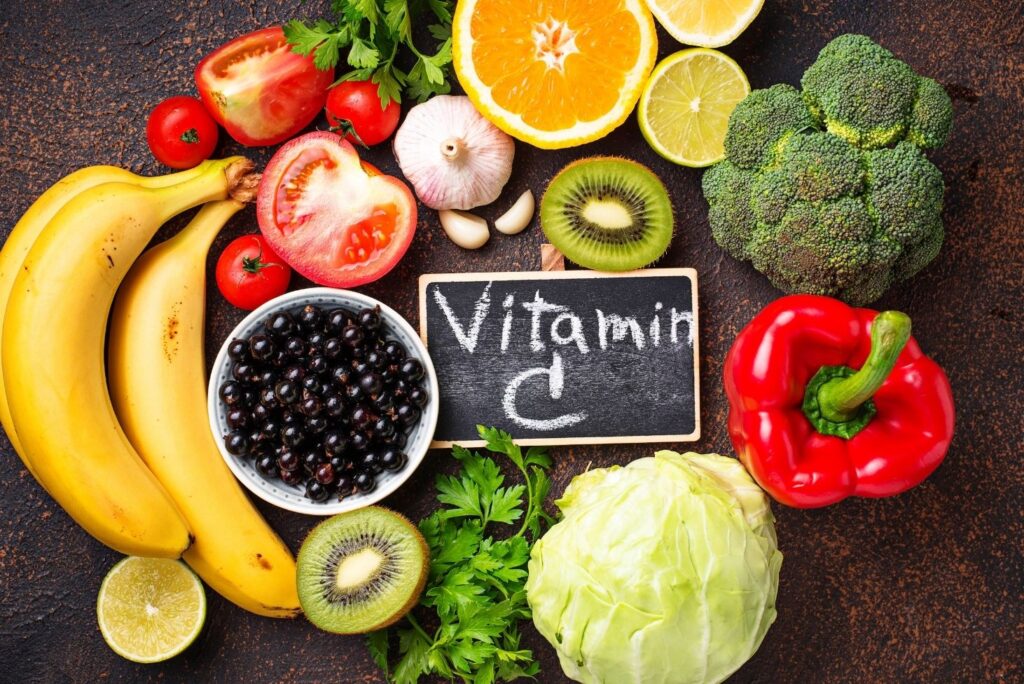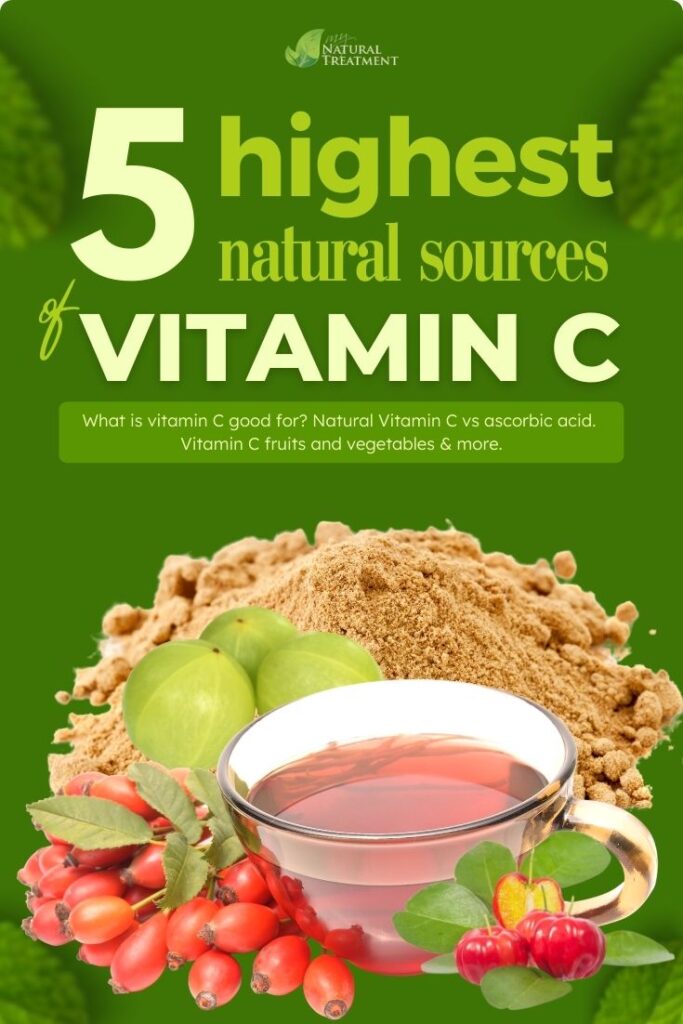Looking for the highest natural sources of vitamin c? Continue reading this article and see what are the best natural vitamin c sources and why natural vitamin c is not ascorbic acid.
Vitamin C is one of the most important vitamins for the human body because it helps us stay healthy and strong because it boosts the immune system tremendously. The good news is that vitamin C has great bioavailability, that is, there are plenty of natural sources of vitamin C in nature. Fruits and veggies are amazing sources of vitamin C, as well as some herbs and spices. Some of them contain the highest content of vitamin C, but before we get to them let’s see what is vitamin C good for, and how to know if you’re low on vitamin C, as well as other key questions.
In This Article You Will Find:
What Is Vitamin C Good For?
Vitamin C has some of the most important health benefits of all known vitamins. Here are the most important health benefits of vitamin C for human health.
- boosts the immune system against viruses, bacteria, yeast, mold, fungus, etc
- increases white blood cell count by strengthening neutrophils, eosinophils, basophils, and macrophages
- has powerful anti-inflammatory properties
- helps heal chronic illness
- detoxes and cleanses the liver, blood, and lymph
- strengthens the adrenal glands (if you’re addicted to caffeine it helps a bunch)
- repairs damaged neurotransmitters and restore the central nervous system
- relieves the mind from stress
- prevents skin aging, wrinkles, and aging spots and repairs damaged skin by boosting collagen and fighting free radicals
- helps in weight loss
- makes you happy (helps with the synthesis of norepinephrine and serotonin)
What Diseases Can Vitamin C Cure?
- cold and flu
- eye problems (cataract, glaucoma, etc)
- asthma and allergy
- anemia
- heart problems (reduces heart attacks and heart failure)
- high blood pressure
- atherosclerosis
- varicose veins and hemorrhoids
- wounds that don’t heal
- aging skin
- insomnia
- adrenal fatigue
- depression, anxiety, and stress
- concentration problems
- poor memory
- nodules, tumors, and cysts
Vitamin C Deficiency Symptoms
Want to know if you’re vitamin C deficient? Look into the most important vitamin C deficiency symptoms, which are:
- frequent colds
- inflammation of the mucous membranes
- varicose veins and hemorrhoids
- excess body weight
- bleeding gums
- wrinkles
- bags under the eyes
- hair loss
- general weakness
- persistent fatigue
- nervousness
- difficulty concentrating
- depression
- sleep disturbances
- lack of vitality and joy of living
- scurvy
What Depletes Vitamin C?
Smoking, heavy drinking, caffeine, a diet rich in fats and sugar (not fruit), certain medication, stress, and living in heavily polluted areas can drastically deplete the vitamin C levels in the body.
Is Vitamin C the Same as Ascorbic Acid?
No. The only thing they share is their chemical structure, that’s why they are mistakenly used interchangeably. Ascorbic acid is the pharmaceutical name for vitamin C and it refers to synthetic vitamin C, which does not have the same healing properties as natural vitamin C. So if you want to buy a good vitamin C supplement, look at the ingredients and see if the vitamin C comes from natural plant or fruit extracts or is just plain synthetic ascorbic acid.
It’s always better to buy a natural vitamin C supplement, even if the vitamin C content is lower than in a supplement with synthetic ascorbic acid, because the body only knows how to use natural vitamin C, and not the synthetic kind. Plus, you get vitamin C from fruits and vegetables too, so don’t solely rely on supplements to do the work.
This is a popular practice in the pharmaceutical industry to put an equal between a synthetic and a natural extract and when the synthetic version doesn’t have the claimed health benefits in studies, they say neither works. Even if they are two different things, one made in the lab and one extracted from a plant or fruit. So beware, and always choose the natural vitamin C.
5 Highest Natural Sources of Vitamin C
1. Rose Hips
(Rosa canina)
Rose hips are one of the highest natural sources of vitamin C but are also rich in polyphenols (such as garlic acid, catechin, and quercetin), vitamins A, C, E, B, B1, B2, PP, K, and carotenoids (β-carotenoid, lycopene β-cryptozanthin, rubizanthin, zeazanthin, and lutein), unsaturated fatty acids, flavonoids, and mineral salts, etc.
More so, studies showed rose hips showed higher antioxidative properties than other well-known antioxidant fruits. The health uses of the natural compounds found in rose hips are staggering, as studies reveal. According to the Medical Medium, the vitamin C in rose hips is the most bioidentical and bioavailable form of vitamin C in existence – that is, the most usable form of natural vitamin C for our bodies. The good news is that:

100 g of rose hips are packed with 400-1500 mg of natural vitamin C, way above the daily recommended dose.
Also good to know is that wild rose hips gathered from higher altitudes up in the mountains have the highest vitamin C content.
Rose Hips Vitamin C Recipe
To make the most of it, you can prepare a simple rose hip jam with raw honey. You can use freshly picked rose hips or dried rose hips. Wash the rose hips and bring them to boil in water. The water level should be two inches above the berries. Stir occasionally. After the rose hips have softened, pass them (together with the water) through a fine sieve, to remove the seeds.
This will get you a fine paste-like jam. If it’s too watery you can continue to boil it down for a few minutes, but keep in mind that after it cools down it thickens a bit more. After the paste has cooled down a bit, add raw honey to taste and pour the rose hips jam into small glass jars. Seal and keep in your pantry.
How to Make Rose Hip Tea
Another way to extract Vitamin C from rose hips is to make a delicious rosehip tea combined with dried flowers and buds from the Japanese acacia tree (Sophora japonica – Huaihua), which are rich in natural vitamin P. The antioxidant rutin in the flowering buds of the Japanese acacia protects vitamin C, while vitamin C promotes rutin, so there is a so-called synergistic therapeutic phenomenon. That is why this combined tea is recommended.
Before making the tea, put the dried rose hips in the sunlight for five minutes to help them activate their memory and healing powers. Steep for 10 minutes and drink the tea with raw honey and fresh lemon juice to boost even more the natural vitamin C. In addition to the rosehip tea, you can also supplement with rose hip powder (2 teaspoons a day in a cup of water or in a fruit smoothie).
2. Acerola
(Malpighia glabra)
One of the highest natural sources of vitamin C is acerola cherry. Also known as the Barbados cherry, acerola is native to Paraguay and Brazil in South America, where it has been traditionally used as a food, and eaten as is or in juices and pulps, baby foods, and as natural vitamin C supplement. Today, the acerola tree is widely cultivated for the extraction of natural vitamin C. Actually, most of the natural vitamin C supplements available on the market today are obtained from the fruits of acerola.
Acerola contains about 1677 mg of vitamin C are in 100 g of fruit.
In addition to vitamin C, acerola cherries contain a lot of powerful healing antioxidants, such as red pigments (flavonoids), organic acids, and a great number of vitamins (A, PP, B1, B2, B3), etc. Thanks to these therapeutically active substances, the healing power of vitamin C-rich extracts from acerola is tens of times stronger than that of the same content of synthetic vitamin C. Acerola powder is the most natural way to supplement the body with vitamin C from this fruit, which you can add to fruit smoothies as a natural go-to vitamin C supplement when you’re feeling weak or coming down with something.

3. Camu-Camu
(Myrciaria dubia)
Camu-camu is one of the highest natural sources of vitamin C that has gained more exposure over the past few years. This cherry-like fruit (similar to acerola in looks and vitamin C content) is native to the Amazonian rainforests and grows abundantly in Peru and Brazil.
According to studies, camu-camu contains anywhere between 2400 and 3000 mg per 100 g in the pulp of the fruit.
The vitamin C content diminishes during storage, but it still retains a considerable amount of natural vitamin C, higher than most other fruits. If you don’t live in Southern America where camu-camu fruits are available, or can’t get the actual fruit or natural fruit juice, you can supplement on camu-camu powder. Beware, this powder tastes very bitter and astringent, so don’t expect too much in terms of taste, but rather focus on the health benefits it offers.

4. Kakadu Plums
(Terminalia ferdinandiana)
Kakadu plums come from the Australian continent, where they have been traditionally used by aborigines as a food source, but also as medicine. These high vitamin C fruits taste pretty bland with an astringent touch and they are traditionally used to prepare jams and sauces. Besides their high content of vitamin C, Kakadu plums are loaded with antioxidants, containing nearly 5 times higher levels of antioxidants than blueberries.
Kakadu plums contain 2300–3150 mg of vitamin C in 100 g wet weight.
However, according to a 2016 study, the fruit and leaves of this tree are also packed with oxalic acid. Interestingly, the symptoms of consuming high content of oxalic acid are the same as overdosing on synthetic ascorbic acid, because the synthetic ascorbic acid is converted by the kidneys into oxalic acid. Kakadu plum powder is the safest way to supplement with natural vitamin C from this fruit.

5. Amla Berry
(Emblica officinalis)
One of the most popular Ayurvedic medicines, amla berry is also one of the highest natural sources of vitamin C on the planet. But the multitude of health benefits of amla berries makes them one of the best natural supplements for boosting immunity, fighting inflammation, and even preventing cancer.
Amla berries contain 600 mg of vitamin C per 100 g of fruit.
A recent study revealed that a combination of amla with piperine extracts had a higher concentration of vitamin C when compared to synthetic vitamin C, probably due to piperine which is a bioavailability enhancer. Hence, amla extract with a dash of freshly ground black pepper is a great natural alternative for synthetic vitamin C. Indeed, amla is one of the highest natural sources of vitamin C.

Foods High in Vitamin C
Top Vitamin C Fruits
The fruits that have the highest vitamin c content are, fully ripe (and ideally freshly picked):
- kiwi
- guava
- lemons and limes
- orange
- tangerine
- grapefruit
- cherries
- apples
- blackcurrants
- strawberries
- melon
- pineapple
- mulberries
- chestnuts
- bananas
- blueberries
- grapes
- sea buckthorn
Did You Know? Lemons with entire pulp (without peel) have a 20 times higher concentration of vitamin C than lemon juice.
Top Vitamin C Vegetables & Herbs
The vegetables that have the highest vitamin c content are:
- red cabbage
- white cabbage
- cruciferous
- tomatoes
- potatoes
- hot chili peppers
- red bell peppers
- cucumbers
- fennel (and fennel juice)
- parsley
- chervil
- tarragon
- pollen
How Much Vitamin C Per Day?
The daily recommended dose of vitamin C required varies, as follows:
- Infants: 300 mg
- Children between 1-14 years: 300-900 mg
- Adolescents and young adults (up to 20 years): 1000 mg
- Pregnant and breastfeeding women: 1000-1250 mg
- Adults: 500-1000 mg
However, in healing chronic conditions, the dose of vitamin C may need to be way above these recommendations. The good news is you cannot overdose on vitamin C, but opt for a natural extract with little to no excipients or preservatives, otherwise, you can overdose on these additives.
Try to get the most of your daily dose of vitamin C by eating fresh fruits, vegetables, and herbs instead of taking supplements, and only supplement with vitamin C when you either recover from illness (cold, flu, etc), feel that you need to strengthen your immune system or experience any of the symptoms of vitamin C deficiency. For every 100 g of the following fruits and berries, you supplement with the natural amounts of vitamin C:
- rosehip = 400-1500 mg vitamin C
- blackcurrants = 100-400 mg vitamin C
- grapefruit = 50-100 mg vitamin C
- lemon = 50 mg vitamin C
- parsley = 100-200 mg vitamin C
Tip! Sunshine exposure boosts the vitamin C in the body, so spend some time in the sun daily while supplementing on vitamin C.
Can You Overdose on Vitamin C?
No. Natural Vitamin C is not toxic and you can’t overdose. The reason is that any excess vitamin C is excreted in the urine within 24 hours. The kidneys retain a small amount, which they reintroduce into the metabolism. After ingesting an excessive amount of natural vitamin C, the body uses only about half and flushes out the rest.
However, we can’t say the same thing about synthetic vitamin C (ascorbic acid). In its pure state, without the cofactors that accompany vitamin C in plants, ascorbic acid is converted by the kidneys into oxalic acid. In large quantities, oxalic acid is poisonous, as it blocks the elimination process and combines very easily with calcium, forming so-called kidney stones or stones. Opt for natural vitamin C extracts and supplements, so you don’t also overdose on excipients and preservatives in poor-quality Vitamin C supplements.
Beware! Overdosing on synthetic vitamin C can cause massive loss of calcium from the body, disrupts the activity of the gallbladder, causes kidney stones, nosebleeds and diarrhea.
Natural Vitamin C Vs Fake Vitamin C. How to Tell?
There are supplement producers who, in violation of the law, claim to sell natural vitamin C extracted from acerola or rose hips, but in reality, they use synthetic ascorbic acid.
The easiest way to spot a fake vitamin C (synthetic ascorbic acid) from real natural vitamin C is to look at the concentration.
Natural vitamin C can be extracted in concentrations of 17% or a maximum of 20% because otherwise, it degrades. Synthetic vitamin C, claimed to be extracted from rosehips and acerola, is in much higher concentrations of up to 100%. Thus, a capsule of authentic natural vitamin C can contain around 10-30 mg of vitamin C, while a synthetic vitamin C pill can reach a whopping 1000-1500 mg of vitamin C. And that’s how you know it’s a fake “natural” vitamin C supplement.
Now that you know what are the highest natural sources of vitamin C, what vitamin C is good for, and how to spot a natural vitamin C supplement from a fake synthetic vitamin C, we hope you’ll make more informed decisions about your health. If you’ve enjoyed this information here, please share it on social media so more people can use it. Stay healthy, naturally!




2 comments
An absolutely thorough and enlightening article!! Thank you so very much for selflessly sharing your knowledge, Andreea.
Hi Donna! Thank you so much for your kind words! Much health to you and yours!💚